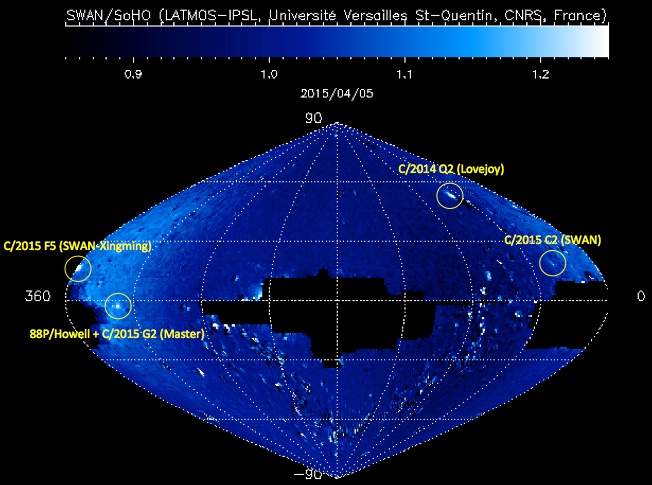TWO NEW COMET DISCOVERIES
2015-April-11
The discovery of two new comets were announced yesterday. Both are bright enough for small telescope observers at ~10th magnitude.
C/2015 F5 (SWAN-Xingming) was discovered by a number of people in publicly available data from the SWAN instrument on the SOHO spacecraft. This is the third comet discovered in SWAN data this year. It became visible in the SWAN data on March 29 UT. According to the Central Bureau of Astronomical Telegrams, the first reports of the comet were received on April 4 UT from Szymon Liwo (Swidnica, Poland) and Worachate Boonplod (Samut Songkhram, Thailand). The next day the comet was independently discovered by Guoyou Sun and Xing Gao (XinJiang, China) on images taken with a 0.11-m f/5 refractor in the course of their Xingming sky survey. At the time of their discovery C/2015 F5 was only 22 degrees from the Sun!
Perihelion occurred on March 28 at a small distance of 0.35 AU. Closest approach to Earth will be on April 14 at 0.60 AU. The comet is currently only 10th magnitude and should rapidly fade as it moves away from the Earth and Sun. As of today (April 11), it is a morning object located in Andromeda at an elongation of only 25 degrees. Over the next few days it passes well north of the Sun and becomes an evening object as it moves through Andromeda (Apr 10-18), Perseus (18-24) and Auriga (24-30).
C/2015 G2 (MASTER)
The second recent discovery was found on Apr 7 UT on data taken by the MASTER (Mobile Astronomical System of the Telescope-Robots) program with a 0.4-m f/2.5 telescope located at the South African Astronomical Observatory. At discovery, Comet MASTER was located very close to 9th magnitude comet 88P/Howell. As a result, observers monitoring SWAN data could not differentiate between the new comet and 88P (SWAN’s resolution is very poor).
Comet MASTER is still inbound and will pass perihelion on 2015 May 23 at 0.78 AU. Closest approach to Earth is on May 13 at 0.47 AU. Currently 10th magnitude, it may brighten to ~6th magnitude at perihelion. Southern hemisphere observers will be able to follow the comet for the next few months. Unfortunately, northern observers will lose sight of the comet in the coming week or two.
The image below was taken on April 5 from the SOHO SWAN instrument. It shows 5 comets. The other objects in the image are from stellar/galactic sources that weren’t properly subtracted from the data. The coordinate system is in ecliptic coordinates with the Earth at 180,0 and Sun at 0,0.
- Carl Hergenrother (Comet Section)




